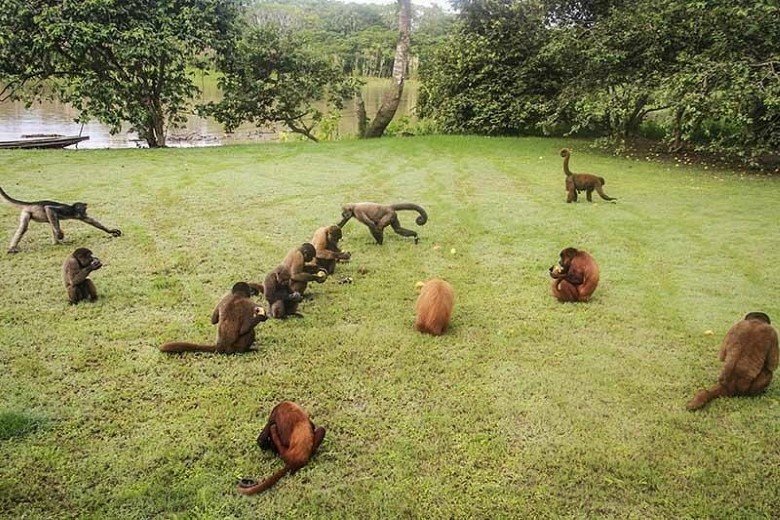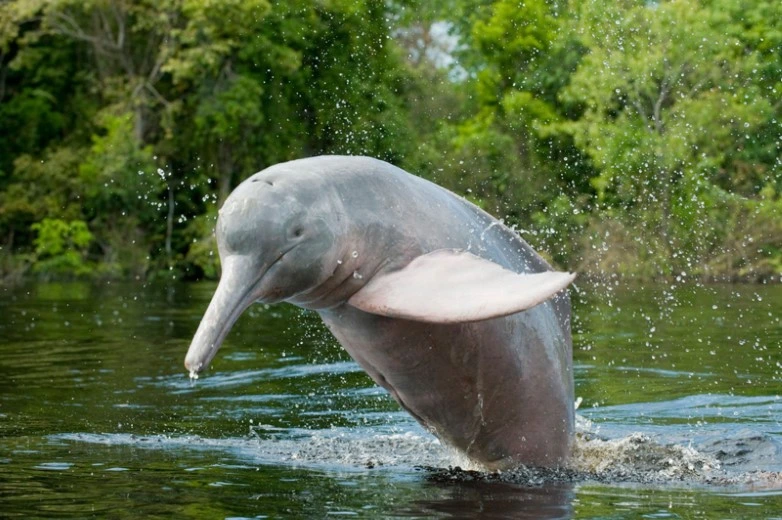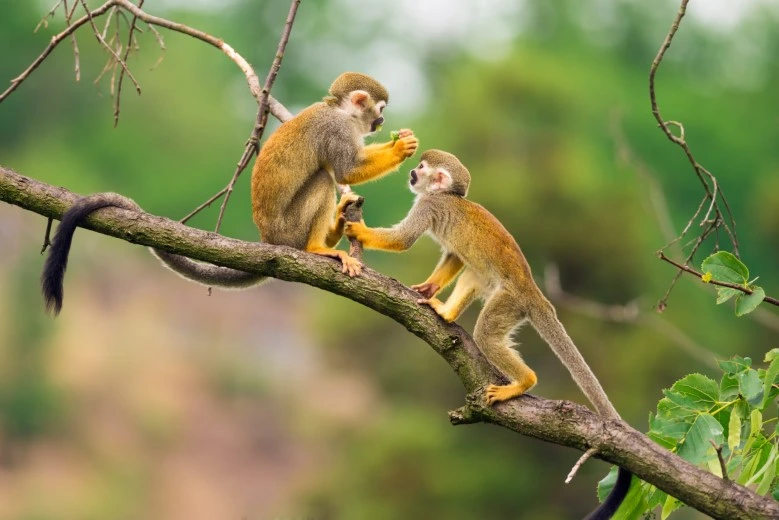If you’re thinking about visiting Iquitos in March, there are a few important things you should keep in mind. This month is part of the rainy season, so it’s common to experience heavy rains, high humidity, and warm temperatures. However, despite the humid weather, the jungle is at its most vibrant: rivers are swollen, the landscape is greener, and nature feels more alive than ever, with increased animal activity.
In this guide, we explain everything you need to know in a simple way to help you plan your trip to Iquitos in March: the month’s pros and cons, key weather facts, and the best places to visit. With this information, you’ll be able to confidently decide if March is the perfect time for your Amazon jungle adventure.

Advantages of visiting Iquitos in March
- Lush vegetation: The rains intensify the greenery of the jungle, offering a spectacular landscape ideal for photography and flora and fauna observation.
- Aquatic wildlife sightings: Pink dolphins and caimans are often seen more frequently along the riverbanks, especially when the water covers floodplains.
Disadvantages of visiting Iquitos in March
- Heavy rainfall: March is one of the rainiest months of the year, with an average of 313 mm (12.3 in) of rainfall, which can interrupt some outdoor activities.
- Frequent rainy days: There are around 18.4 days of rain, meaning wet conditions are common and may impact your excursions or outdoor plans.
- High humidity: The environment is extremely humid this month. This increases the presence of mosquitoes and makes the heat feel more intense and suffocating.
- Slippery trails: Rain makes jungle trails slippery and difficult to walk, increasing the risk of falls or accidents while hiking.
- Insects and mosquitoes: Humidity and standing water favor the proliferation of insects, especially mosquitoes. This can make the experience uncomfortable if precautions aren’t taken.

Iquitos Weather Data in March
- Total precipitation: 313 mm (12.3 in) for the month, making it one of the rainiest in the region.
- Rainy days: 18.4 days with at least 1 mm of precipitation.
- Average high temperature: 31 °C (88 °F) during the day.
- Average low temperature: 24 °C (75 °F) at night.
- Average temperature: 27 °C (81 °F), ideal for those who enjoy tropical heat.
- Daily chance of rain: 85% chance of rain on any given day in March.
- Daylight duration: About 12 hours and 6 minutes of natural light.
- Sunrise: Around 5:58 AM.
- Sunset: Around 6:05 PM.

What to See in Iquitos in March
- City tour of Iquitos and Belén Market: Explore the city with a bilingual local guide, visit the floating neighborhood of Belén and its famous market, where you’ll find unique products like chonta, aguaje, and a wide variety of medicinal plants such as ayahuasca, cat’s claw, and garlic sacha.
- Tour of the Nanay River and dolphin encounter: Sail the Nanay, Itaya, and Amazon Rivers, and observe the natural phenomenon where muddy and black waters meet. During this trip, you’ll likely spot pink and gray freshwater dolphins.
- Visit to Chullachaki Ecomuseum and Fundo Don Pedrito: Discover Amazonian culture at the ecomuseum, where you’ll learn about medicinal plants and traditional drinks. Then, visit Fundo Don Pedrito, a fish farm with paiche and captive caimans.
- Exploration of San Juan de Huashalado and Yanayacu: Walk through the community of San Juan de Huashalado, then continue by boat to Yanayacu Eco Lodge, surrounded by untouched nature and wildlife.
- Monkey encounter and Yagua community visit: Visit Monkey Island, a rescue center where you can interact with primates. Afterward, meet the Yagua community and enjoy their traditional dances and crafts.

What to Do in Iquitos in March
- Taste Amazonian cuisine in Belén: Try exotic dishes such as juanes with tacacho, cecina, grilled alligator, and suris (edible larvae), considered a local delicacy.
- Piranha fishing and canoe rides: Join in on traditional piranha fishing and navigate the rivers by canoe, a perfect way to admire Amazonian wildlife.
- Jungle hikes and overnight camping: Go on an ethnobotanical walk through the flooded forest and camp overnight under the stars, enjoying a barbecue-style dinner and local legend storytelling.
- Birdwatching and sunsets in Yanayacu: Enjoy early morning canoe rides for birdwatching, and admire sunsets surrounded by jungle sounds.
- Cultural exchange with the Yagua community: Take part in cultural activities with the Yagua, learn about their ancestral traditions, and dance to the rhythm of their traditional music.
- Night canoe ride and stargazing: Paddle silently through the Amazon rivers after dark to experience a spectacular starry sky and connect with nature.
Frequently Asked Questions About Iquitos in March

1. What clothes should I bring for a trip to Iquitos during the rainy season?
It is recommended to bring light, quick-drying clothes, a raincoat or waterproof jacket, rubber boots for hiking, and long sleeves to protect yourself from insects.
2. Is it safe to travel to Iquitos in March?
Yes. Local guides know safe routes and have boats suitable for high water levels. It is only important to follow their instructions and wear non-slip footwear.
3. Which nature reserve is best to visit in Iquitos in March?
Pacaya-Samiria National Reserve and Allpahuayo-Mishana Reserve are excellent options. Both offer elevated trails and boat-accessible areas, allowing exploration even when the paths are flooded.
4. Can I see pink dolphins in Iquitos in March?
With high river levels, your chances of seeing pink dolphins increase. They often appear in flooded areas and lagoons near Iquitos.
5. What experience is a must in the Amazon rainforest of Iquitos in March?
Night walks let you listen to frogs and birds. There are also early morning boat rides to admire the forest reflected on the river. Additionally, you can visit indigenous communities to learn about their traditions.
6. What to pack for Iquitos in March?
- Reusable water bottle
- Light snacks
- Sunscreen
- Insect repellent
- Small towel
- Camera with waterproof cover

March in Iquitos is rainy and humid, with warm temperatures and lush nature. It’s ideal for spotting aquatic wildlife and exploring the jungle, though you should be prepared for slippery trails and mosquitoes. Bring waterproof clothing, insect repellent, and boots. Book your adventure now with Peru Jungle Trips and immerse yourself in the Amazon rainforest.
Tours in Iquitos you may be interested in:
- Iquitos Amazon Tour (3 Days) – Private
- Iquitos Jungle Tour (4 Days) – Private
- Iquitos Peru Amazon Tours (5 Days) – Private
Discover Iquitos in April: What you need to know before you travel and how to make the most of your trip.
➜ Iquitos in April: Complete Guide to Exploring the Peruvian Jungle
All About Iquitos in February: Weather, Advantages, and Disadvantages of the Peruvian Rainforest
➜ Iquitos in February: Complete Travel Guide to the Amazon Jungle

